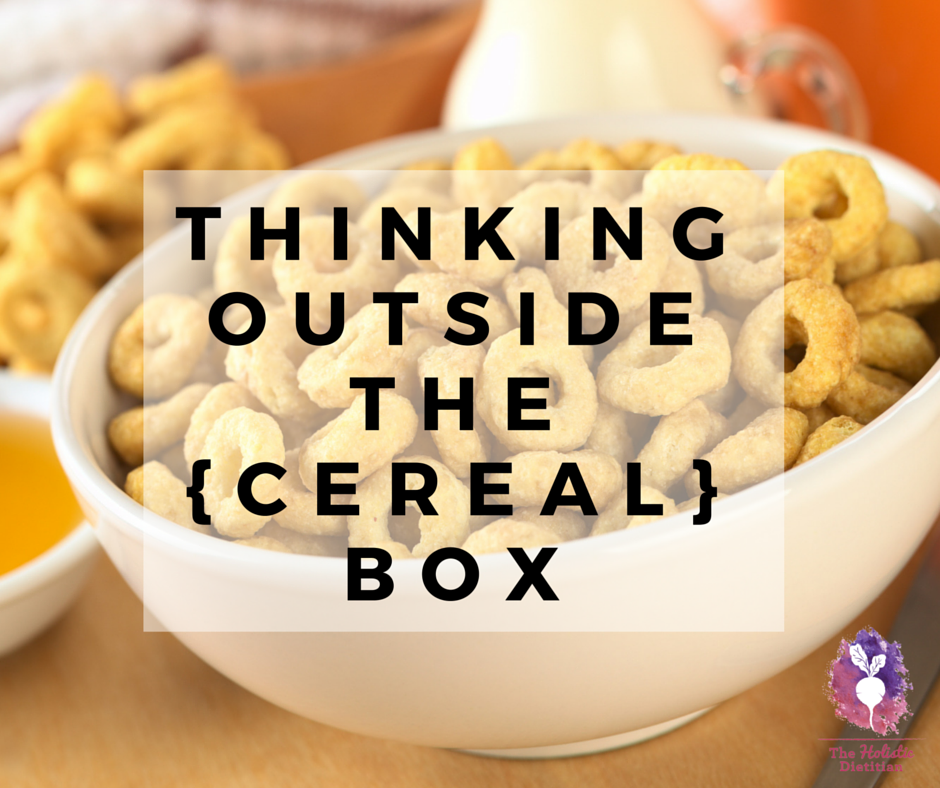
I used to eat cereal for breakfast every day. It was a quick breakfast that I could scarf down as I was scrambling to get ready for school or for work. And plus, it’s what “they” say is a healthy breakfast, right?!
Not so much.
Cereal boxes are slathered with all sorts of marketing ploys, such as “may help reduce cholesterol”, “great source of fiber”. The American Nutrition and Dietetic Association and American Heart Association claim that it’s a heart healthy breakfast. But the reality is that ALL cereals, even the ones considered to be the more healthy ones (i.e. Kashi) are so highly processed, that they provide little to NO nutritional value.
Ultra-processed
All packaged cereals are produced by a process called “extrusion”, which forms the grain into shapes such as little o’s, flakes, or shreds. This involves high heat and pressure, destroying most of the nutrients, including some of the chemical vitamins that are added to “fortify” the cereal. Extrusion especially targets amino acids (the building blocks of protein) causing them to be vastly altered, and as a result, new compounds form which are potentially harmful. (source)
Not-so-Fortified

Cereals even claim that they are “fortified” with vitamins, but these are synthetic (man-made) vitamins that the body is simply not designed to utilize. Synthetic vitamins are often excreted (or, dumped) quickly from the body because they body isn’t quite sure of what to do with them. If any do linger around, they can cause imbalances within the body. Not to mention that certain key nutrients cannot be absorbed without fat. So if you’re using low-fat or skim milk with your cereal, you’re not absorbing those added nutrients anyways.
Triggers Blood Sugar Imbalances
Ever eat a bowl of cereal.. or two.. and feel hungry just an hour later? It’s because cereals, primarily a carbohydrate, break down into sugar and is shuttled into the bloodstream quickly, especially if you’re using a milk sans fat. This will trigger a blood sugar “high” and in turn cause a blood sugar crash afterwards. This leaves you feeling hungry, tired, and possibly even a little irritable. So what do you do? You grab a quick snack to tide you over until lunch (probably a carb), that causes you to hop right back on that blood sugar roller coaster. If on the other hand, you eat a well balanced breakfast that includes a healthy balance of protein, fat, and carbohydrates, you will feel more satiated and also be able to absorb the key nutrients you need for your day.

are our “healthy” breakfasts contributing to the obesity epidemic?
When we eat a breakfast that is considered to be a go-to “healthy” meal, such as cereal + orange juice, think of all the carbohydrates in this meal alone (up to 77+ grams!). This triggers the release of the hormone insulin, which works to allow the entry of glucose in to the cell and out of the bloodstream. But here’s the deal.. insulin also works as a fat storage hormone. If we have a chronic release of insulin, constantly having an output of insulin to manage our blood sugars, this can even lead to insulin resistance and further down the line, diabetes.
(We talk a lot more about this in my RESTART® program.)

Other quick breakfast options:
· Breakfast hash with sausage, diced sweet potatoes, onion, and diced apples.
· Omelette with bacon crumbled and desired veggies.
· Smoothie (half fresh or frozen fruit, half veggies/greens, blended with whole organic milk (raw if possible), unsweetened coconut milk, or unsweetened almond milk) with a handful of nuts on the side. Read my warning about smoothies and how to build a better smoothie.
· Whole fat yogurt (unsweetened), topped with fruit and nuts.

· Breakfast casserole: eggs, spinach, basil, bell pepper, sausage, etc.
· Salmon Bowl: leftover salmon with veggies
· Egg “muffins”